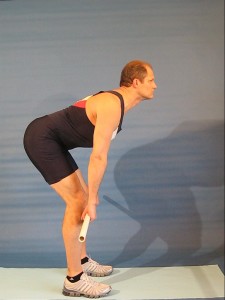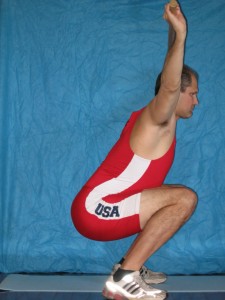Look for Coach Kaehler’s up-coming fitness column in Rowing News
December 21, 2009
Coach Kaehler is excited to announce that he will begin writing a monthly fitness column for the “Rowing News” starting in January of 2010. Also continue to enjoy new articles being posted on the Coach Kaehler web site as well. Topics ideas are always welcome.
Does Strength Training Help Improve Your Flexibility?
March 25, 2009
Recent research has look at this question with interesting results. Most often people use passive stretching as the main method to try and increase flexibility in particular muscle groups. Passive stretching has been shown to improve flexibility if consistently done over a long period of time. The question is can you combine your flexibility training into a strength program? And if so what movements improve flexibility?
An article posted in the Journal of Strength and Conditioning Research in May of 2008 titled “Influence of Strength Training on Adult Women’s Flexibility” (Monteiro, Simao, et.al) looked at how 10 weeks of strength training influenced flexibility in sedentary middle-aged women. The exercises used in the study included bench press(free-weight), Smith squat machine, anterior wide grip lat pull-down, 45-degree leg press, 30-degree inclined bench press, hack squat machine, and abdominal crunches. The average age of the women in the study was 37 years + 1.7 years. This particular study demonstrated that after training for 10 weeks and going through three (3) circuits of 8 to 12 repetitions of the seven (7) exercises listed above, that significant improvements in range of motion occurred with the following movements; hip flexion and extension, trunk flexion and extension and shoulder horizontal adduction. The areas that did not improve range of motion where elbow and knee flexion. While this study did show that strength training can improve flexibility in sedentary women, the next question is are there strength exercise movements that can improve flexibility in rowers? To my knowledge there are no studies that have looked at rowers and how strength training would influence flexibility. The above study did demonstrate increased hip flexion, which is critical in rowing, and so the use of the squat machines did increase hip flexion range of motion. What the above study did not look at is how hamstring mobility was affected by the above strength training program. This would have a lot of relevance to an effective rowing stroke.
From my own coaching experience I believe that there are several key lifting movements that will certainly increase flexibility in rowers in a positive way, if they are done properly. These strength movements include the “overhead squat” and “straight-leg dead lift”. Both of these lifts require a higher level of body control and awareness and people who attempt these positions should try and get a professional to look to make sure proper technique is being used. In general these open movements are better than strength training machines used in the above study. This is because the neural input needed from the athlete is greater with open movements, and the carry-over is probably better as well.

Straight Leg Dead Lift

Over Head Squat
“Other research on flexibility training has focused on developing effective strategies to increase the range of motion and identifying the factors that limit flexibility. There has been some disagreement over whether one’s limitation’s in flexibility is really from the inability to completely relax the involved muscles. Studies have shown that range of motion is much greater when a person is completely anesthetized, Walsh (1992) suggested that the inability to relax is a major limitation in the range of motion about a joint.” (Enoka, 2002).
Often we hear our coaches tell us how important it is to relax in the boat of no the erg which will help to produce a long and powerful stroke. Relaxation allows for a more complete range of motion through all the joint movement in the rowing stroke. Training movements repeatedly help to improve relaxation of a motion. There are few sports that require as much flexibility as rowing (Olympic lifting and Gymnastics), so flexibility is a critical component to effective and powerful stroke rowing strokes.
**When strength training it is advised that you are under the supervision of a trained professional to assist with proper technique to reduce injury risk.
Have a Great Training Day!
Coach Kaehler
References;
Enoka, Roger M. Neuromechanics of Human Movement. New York: Human Kinetics, 2001.
“Influence of Strength Training on Adult Womens flexibility.” Journal of Strength and Conditioning Research, 22 (3), 2008: 672-77.
Optimum Performance and the Use of Caffeine
January 11, 2009
Do you grab a quick caffeinated beverage before racing, or chug a caffeinated sports drink during your workout? Many athletes believe consuming a shot or two of caffeine is an ideal way to get that quick boost of energy in the quest for better performance. However the effects of caffeine on your endurance training may not be giving you the results you are looking for. Of course, many people use caffeine throughout their day to help stimulate them during daily activities and energize them during their workouts. Understanding the effects that caffeine has on a body is important in deciding whether or not to use caffeine as part of your training program.
Caffeine is actually a toxic stimulant found in nature. Although it revs the body up, it provides zero in terms of energy. After ingesting caffeine, your body automatically begins the process of metabolizing (getting rid of) it. This metabolic activity actually costs you energy and takes it from your storage of nutrients. Therefore a stimulant like caffeine triggers an abnormal “speeding up” reaction to begin eliminating it. This “speeding up” is the caffeine buzz you feel, but in actuality it is depleting your body of necessary energy and nutrients.
Not only does the process of metabolizing caffeine use up energy, it has diuretic effects (fluid loss) as the body tries to clear it from your system. This creates a negative water balance in your body, leading you to urinate more. Coupled with the elevated heart rate usually caused by caffeine, the diuretic effect could lead to over-stimulation of your body, potentially leading to dehydration in people already pushed to their physical limits. During this process of elimination we can be fooled into thinking that the stimulant is an energy value, when really it is an energy cost.
A recent article published in The Journal of Strength and Conditioning Research, titled “Caffeine and Endurance Performance”, by Matthew S. Ganio, et al., is a systematic review of 21 different studies which measured performance with a time-trial test. They looked at endurance events that were at least five (5) minutes or longer, such as cycling, running, etc. The authors of this study concluded that although the performance improvements were varied among the studies researched, they found that factors including timing, ingestion mode/vehicle, and subject habituation may have influenced study results.
One significant recommendation Ganio, et al., made from this review was that endurance athletes abstain from caffeine use at least seven (7) days before competition to maximize its ergogenic (boosting) effect. Also, it was noted by Ganio, et al. that if caffeine is used for an ergogenic effect, it should be ingested within 60 minutes or less of competition or training. The amount of caffeine commonly shown to improve endurance performance is between 3 and 6 mg. per kg-1 body mass. The caffeine benefit was equally effective when consumed with a carbohydrate solution, gum, or water alone, however coffee was noted to not to be as effective a caffeine source. When caffeine is used on a regular basis, the ergogenic effect is not as great, compared to using it sporadically or not at all.
Overall, chronic use of caffeine appears to have far less effective results in time-trial testing, and appears to cost the body energy and nutrients in elimination from the body on a daily basis. However, should an athlete decide that caffeine use is beneficial, it would make sense to follow the guidelines for amounts ingested and limit use during time trials spaced seven days or more apart, prior to race day. Determining the best use of caffeine, if any, is a personal decision best made with the advice of your physician and coach.
Before grabbing that caffeinated sports drink, consider the effects of caffeine on your body. Because of the generally negative effect that metabolizing caffeine has on a body, Coach Kaehler does not advocate the use of caffeine as a regular part of a training program. Instead, he believes that a well balanced, specially designed training and nutrition program is much more effective for achieving the maximum performance results desired on race day.
Coach Kaehler has posted this for informational purposes only, and that the use of caffeine for performance enhancement is a personal preference. It should be noted, however, that he does not recommend the use of caffeine for the clients he trains.
Endurance Sports Coaching
October 28, 2008
A couple of words about endurance sports coaching will go here.
